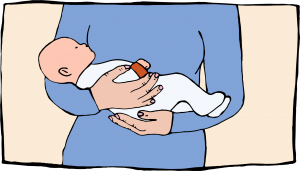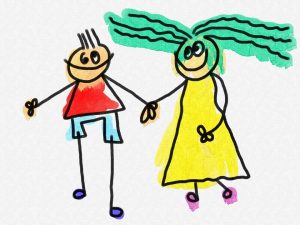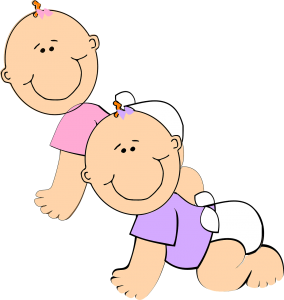childhood

Human babies are born with a relatively large head on a small body and short folded limbs. Other mammals, like puppies, kittens, lambs, foals, calves and elephants, to name a few, stand up on their own feet and walk to their mother’s nipples to feed themselves within a few hours after birth, but the human baby needs about a year to learn to walk.
Learning skills
For animals the nursing period (during which the young is breastfed) is long enough to learn how to find food and avoid dangers: when the young is weaned (taken off the breast) it can take care of itself. But the human young needs years to learn how to eat their food in the appropriate manner (relative to their culture) and even longer to buy food and cook their own meals.
In the course of evolution humans have developed a more complex life style than any other species. Obviously, a longer childhood is required for learning all the skills we take for granted. Childhood ends with sexual maturity, but in modern society education usually goes on for many more years after that.
Motor development in childhood
Human walking is a very complex process, the result of a long evolution leading to our present body shape with its innate possibilities directed by our present nervous centre guided by the brain.
The beginning of movement
How did movement in living organisms begin? Bacteria turn away from a one degree of acidity or are drawn to another. This may be called the simplest type of movement, which is always related to environment. More complex organisms developed noses, eyes and ears, usually at the front of their bodies, close to their brain. Fish have grown fins and tails to move fast in flight or to catch a prey. The same or other tasks are performed by flying and stalking, running and slithering , swinging, jumping or walking.
The use of hands
The use of our hands develops in a similar way as the use of our legs and feet. The infant is very eager to practise grasping, throwing, hitting, clapping, and so on. In the beginning those movements are not very precise. Later, they get more refined, and the toddler can build a block tower, hold a felt pen or brush and draw or scribble, zip and button its clothes. Later it will learn to string its shoes, use a vending machine and the telephone, surf on the internet and play a musical instrument.
Differences between boys and girls
The individual differences in capacity for gross and fine motor development are considerable. Generally speaking, boys and girls show marked differences in every aspect of their behaviour, so also in their motor skills, which are already sexually biased at a very early age. For instance, boys are better at, and more interested in, gross motor activities like sports, while girls generally prefer fine motor skills like dressing a doll. However, to understand the differences between males and females we must take many more differences into consideration. Ultimately the differences are all related to the baby-bearing function of the female in all life forms preceding us. Toilet training, learning to eat and talk all follow the same pattern of interaction between the senses, the nervous system and the muscles.
The general pattern
We can distinguish the following general pattern:
- A genetic blue print is present from the moment of conception. The embryo interacts constantly with its immediate environment. The foetus can feel its mother’s heart beat and is probably affected by her emotions. The older foetus can hear voices and music. So even before birth a human being is influenced by its environment, inside the woman as well as outside.
- After birth the parents and others interact with the baby and help to develop or frustrate its inborn potential.
- There are certain ages, called sensitive periods, in which children are naturally inclined to learn certain skills. Learning to walk after the second birthday is much more difficult than before; learning to speak after the tenth, if the child has never heard a language spoken, is even harder: the brain area that is responsible for speech has by then deteriorated seriously.
- Development continues to the point where it reaches its full-grown potential. After that it can still change, but only to a small extent.

